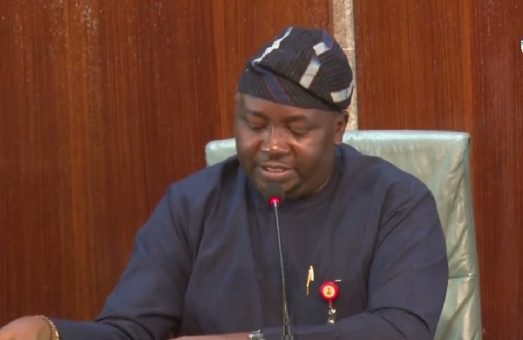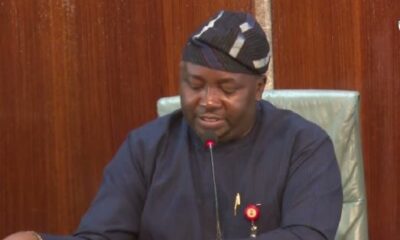Energy
NUPRC achieves conversion of first PPL from 2020 Bid Round

- Ingentia Energies pledges delivery of over 5 wells
The Nigerian Upstream Petroleum Regulatory Commission (NUPRC) has successfully overseen the conversion of Petroleum Prospecting Licence (PPL) 202 to Petroleum Mining Lease (PML) 66, a landmark achievement that reinforces Nigeria’s standing as a prime destination for both local and international oil and gas investors.
This milestone not only signifies the successful transition of a key asset but also highlights the transformative potential of the Petroleum Industry Act (PIA) 2021.
The Commission’s Chief Executive (CCE), Engr. Gbenga Komolafe, made these remarks at the Signing Ceremony of Petroleum Mining Lease (PML) 66 between Ingentia Energies and its shareholders in Abuja at the weekend.
Describing the event as a significant step in the implementation of the PIA, the CCE explained that the signing of PML 66 represents the first-ever conversion of a PPL to a PML from the 2020 Marginal Field Bid Round.
The holders of PPL 202 are Suntrust Oil Company Nigeria Limited, Petrogas Energy Trade W.A Ltd, Somora GTP Limited, Moore Oil Exploration & Production Nig Ltd, and Genesis Hydrocarbons Limited.
Engr. Komolafe remarked: “This milestone achievement follows the successful commercial discovery of hydrocarbons in the field and the subsequent conversion of the asset in accordance with Section 81(1) of the Petroleum Industry Act. This development clearly demonstrates the value of the bid round and the resilience of our upstream sector.”
“The conversion of PPL 202 to PML 66 further reflects the hard work and determination of the licensees, as well as the guidance provided by this Commission as a business enabler. More importantly, it sends a strong signal to both domestic and international investors that Nigeria remains a top destination for oil and gas investments, supported by regulatory clarity, commercial viability, and operational excellence.”
The NUPRC boss commended the holders of PPL 202, Suntrust Oil Company Nigeria Limited, Petrogas Energy Trade W.A Ltd, Somora GTP Limited, Moore Oil Exploration & Production Nig Ltd, and Genesis Hydrocarbons Limited—for their diligence, professionalism, and dedication in fulfilling their work programs and obligations under their license, which paved the way for this conversion.
Engr. Komolafe stressed that PML 66 is not merely another lease but rather marks the beginning of a new chapter in Nigeria’s oil and gas landscape.
He emphasised: “This underscores the transformative potential of the reforms we have put in place and the shared vision for a more efficient, competitive, and sustainable upstream petroleum industry.”
The CCE also urged other awardees to emulate the exemplary standards demonstrated by the holders of PML 66.
“I also urge them to maintain this positive momentum and ensure that the benefits of this development extend beyond corporate boardrooms to the Nigerian people, in the form of jobs, capacity building, technology transfer, and enhanced revenues for shared prosperity,” he added.
The Managing Director of Ingentia Energies, Mrs. Olajumoke Ajayi, expressed her gratitude to the Commission’s management for their unwavering support and guidance throughout the journey.
She described the signing as a significant achievement for Ingentia, one that the company is proud of, noting that it marks a new chapter in both the history of Nigeria and Ingentia as an indigenous firm.
“This significant achievement marks a new chapter in the company’s growth story and solidifies Ingentia Energies’ position as a rising force in Nigeria’s oil and gas sector. The company’s leadership acknowledged the crucial role played by both shareholders and staff in reaching this milestone.”
“Ingentia Energies Limited is now poised to take its oil and gas operations to the next level, having successfully converted its Petroleum Prospecting Licence (PPL) to a Petroleum Mining Lease (PML). With this development, the company is now focused on delivering sustainable growth and long-term value.”
She added: “Once again, the CCE, we assure you that this job will be done. As we speak, our rig is on its way. We have two wells to drill back-to-back, and we have about three plans for next year. A well is producing between 2,000 to 2,500 barrels per day. The other wells we are bringing online should contribute another 2,000 to 2,500 barrels, and by the end of the first quarter next year, we expect to increase our production by 7,500 barrels.”
The team expressed appreciation for President Bola Tinubu’s leadership in opening the country’s oil and gas sector to further opportunities. Ingentia Energies further pledged to support the Commission’s efforts to raise oil production by an additional 1 million barrels per day, a project launched in 2024.
Energy
8,500 transmission capacity: Low demand stalls generation of 3,500MW

• Nigeria conducts grid synchronisation test connecting 15 countries for four hours
The Ministry of Power yesterday said despite the availability of 8,500MW transmission capacity in the Nigerian Electricity Supply Industry (NESI), low demand from the Distribution Companies (DisCos) has limited generation to 5,000MW, stalling 3,500MW.
As of July 17, 2025, the wheeling capacity was 5,500MW.
But the ministry disclosed its recent wheeling capacity in Abuja during a media briefing where it announced that Nigeria successfully conducted a grid synchronization test with 15 West African countries for four hours on November 8, 2025.
“Today, the minimum grid capacity we can even communicate is 8,500MW of capacity. If our generation reaches 8,000 MW today, the grid can comfortably and conveniently transmit it,” Adelabu said.
Besides, the Nigerian Independent System Operator (NISO), Market Operation Executive Director, Dr. Edmund Eje, explained that since electricity cannot be stored, the industry only generates energy based on demand.
His words: “The amount of energy generated is equal to the amount of energy that will be transmitted, and it is also equal to the amount of energy that is demanded by the distribution companies. It is simultaneously consumed.
“You don’t stall energy anywhere. The transmission capacity can carry 8,500MW, but it can only carry what can be consumed. Generators will not generate more than what will be consumed at the same time.”
On synchronization, he said the feat of successful synchronization will not affect the allocation of energy for domestic consumption.
Eje said that although there is a regulation that Nigeria allocates 600MW for bilateral trade, production constraints presently limit it to 360MW.
Adelabu, however, described the synchronization test success as a step towards the elimination of grid collapse from the industry, noting it means that there is confidence that the system is now resilient.
He described it as a landmark development in the evolution of West Africa’s electricity architecture.
He confirmed that on 8th November 2025, Nigeria successfully conducted a grid synchronisation test connecting the national electricity grid with the interconnected West African Power Pool (WAPP) system.
According to him, the exercise represents the first time in history that Nigeria has operated in a unified, stable, and fully harmonised configuration with the rest of the sub-region.
He clarified that while it is not yet a permanent synchronisation, the successful test clearly demonstrates that regional technical alignment is feasible and marks a major step toward eventual full integration.
Adelabu further noted that the synchronisation exercise, conducted between 05:04 a.m. and 09:04 a.m., involved the Nigerian grid which includes Niger Republic and parts of Benin and Togo and the rest of West Africa’s interconnected systems covering Ghana, Côte d’Ivoire, Burkina Faso, Liberia, Sierra Leone, Guinea, Senegal, The Gambia, Guinea Bissau, and Mali.
He said for four uninterrupted hours, power flowed seamlessly across national borders, operating at a single stable frequency and proving that West Africa is now technically capable of functioning as a unified power bloc.
He said the achievement ranks among the most significant milestones in the history of WAPP.
He said the test marks the first successful large-scale synchronisation attempt since 2007, when a short-lived trial lasted only seven minutes before failing.
Adelabu said Nigeria has made history with the successful synchronization of the national grid with the West African Power Pool interconnected system.
For four unbroken hours, according to him, electricity flowed from Nigeria and Niger into the entire West African sub-region covering Benin, Togo, Ghana, Côte d’Ivoire, Liberia, Sierra Leone, Guinea, Senegal, Mali, The Gambia, and Guinea-Bissau operating at a single, stabilized frequency.
Earlier at the NISO Maiden Stakeholders’ Engagement, the Managing Director, Engr. Abdul Mohammed said the milestone recorded with the synchronization milestone is more than a technical success, since it positions Nigeria as a regional power hub; opens new avenues for electricity trading; unlocks foreign exchange potential; and reinforces investor confidence in the emerging Nigerian electricity market.
According to him, a resilient electricity market requires more than engineering; it requires relationships.
He said it requires trust among service providers, trust between the market and regulators, trust between the government and operators, and, above all, trust from the Nigerian people.
Energy
Brent rises 1.32% to $65 as drone strike halts 260,000bpd Russian refinery

By Grace Edet
Crude oil prices edged higher on Tuesday after a Ukrainian drone strike knocked out one of Russia’s largest refineries, disrupting 260,000 barrels per day (bpd) of processing capacity and raising fresh concerns over global supply stability as winter demand builds.
Brent crude was up 1.32 per cent at $65.05 per barrel at 9:00 WAT, with analysts warning that the outage could trigger further price increases in the coming days.
The Ryazan refinery, Russia’s fourth-largest and operated by Rosneft, has now been hit twice in less than a month as Ukraine escalates its long-range strike campaign. The latest attack halted the plant’s main crude distillation unit, which accounts for roughly 5 per y of Russia’s total refining capacity.
Industry sources told reporters that the refinery will remain shut until at least December 1, adding that “no product deliveries are expected before then,” while several secondary units have also been idled.
Prices Mixed Across the Energy Market
While Brent gained, WTI held steady at $60.90 per barrel, showing no change. Murban crude ticked up by 1.06 per cent to $66.46, whereas natural gas slipped 0.16 per cent to $4.368. Analysts say the muted price response masks rising anxiety beneath the surface.
“Market sentiment has turned cautious. If these outages persist or Moscow’s infrastructure comes under renewed fire, the supply picture could tighten very quickly,” an energy expert, Mustapha Shuaid said.
Winter Demand Meets Heightened Geopolitical Risk
The attack comes at a sensitive period, with temperatures dropping across Europe and Asia. Energy markets typically enter a high-demand phase from late November, making geopolitical disruptions more consequential.
Ukraine’s strategy has increasingly shifted toward high-impact targets. According to the Centre for European Policy Analysis, Kyiv is now focusing on “high-value refinery equipment like cracking units — assets that are harder to replace and more disruptive when damaged.”
Recent strikes have also hit terminals and export routes, including the strategic Novorossiysk port on the Black Sea.
Market Braces for Upside Risk
Although front-month prices remain relatively stable, traders say the underlying risk of a significant price upturn is rising. The outage at Ryazan, combined with the threat of additional strikes, could squeeze Russian product exports and rattle global supply chains.
“The next few weeks will be pivotal. Any escalation could be enough to disrupt balances and trigger a price rally, with spillover inflation risks for energy-dependent economies,” another analyst, Akin Owolabi told TheTrustNews.com.
With the Ryazan plant offline and Russia’s refining network increasingly exposed, the oil market enters the winter season on a fragile footing.
Energy
Diesel falls to ₦979/L in Lagos

By Grace Edet
Diesel prices in Lagos have dropped below ₦1,000 per litre for the first time in months, offering rare relief to transport operators, manufacturers and SMEs.
Market checks on Tuesday showed rates as low as ₦979 per litre at Mobil Idowu Egba, ₦980 at NNPC Retail Igando and ₦995 at Petrocam Isheri, driven by stronger domestic supply and heightened competition among retailers.
But fresh cost indicators suggest the drop may be short-lived. New data from the Major Energy Marketers Association of Nigeria (MEMAN) shows diesel landing cost has climbed to ₦980.28 per litre, signalling pressure on retailers and raising the likelihood of a price rebound.
According to market analysts, the rising landing cost is being driven by firmer international prices, higher cargo premiums and renewed bulk purchases by major distributors seeking to replenish stock.
They warn that the current sub-₦1,000 pump prices do not reflect the cost realities facing importers.
Foreign exchange volatility is compounding the pressure. The naira traded between ₦1,430 and ₦1,450 to the dollar over the past week, creating uncertainty for fuel traders and affecting forward pricing.
New coastal pricing formulas tied to Platts benchmarks are also shaping expectations for higher replacement costs.
Analysts note that Dangote Refinery’s lack of any announced price reduction is another sign that the current relief may not last. Market behaviour suggests wholesalers may soon begin building inventories in anticipation of upward adjustments.
“Diesel may have dipped below ₦1,000, but all cost indicators point to a likely rebound. Rising landing costs and FX pressure will inevitably filter through the supply chain,” a Godfrey Olatunde, a Lagos-based energy analyst told TheTrustNews.com.
With cost drivers now trending upward, stakeholders warn that the modest price drop recorded this week may be temporary as the market prepares for another adjustment.
-

 Art & Life8 years ago
Art & Life8 years agoThese ’90s fashion trends are making a comeback in 2017
-

 Entertainment8 years ago
Entertainment8 years agoThe final 6 ‘Game of Thrones’ episodes might feel like a full season
-

 Art & Life8 years ago
Art & Life8 years agoAccording to Dior Couture, this taboo fashion accessory is back
-

 Entertainment8 years ago
Entertainment8 years agoThe old and New Edition cast comes together to perform
-

 Sports8 years ago
Sports8 years agoPhillies’ Aaron Altherr makes mind-boggling barehanded play
-

 Entertainment8 years ago
Entertainment8 years agoMod turns ‘Counter-Strike’ into a ‘Tekken’ clone with fighting chickens
-

 Entertainment8 years ago
Entertainment8 years agoDisney’s live-action Aladdin finally finds its stars
-

 Business8 years ago
Business8 years agoThe 9 worst mistakes you can ever make at work














